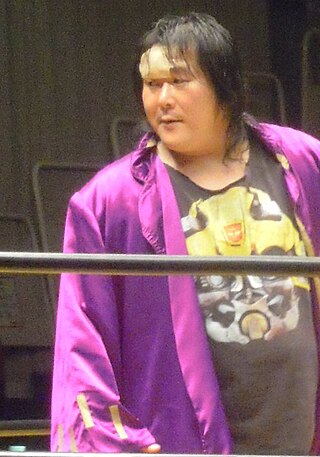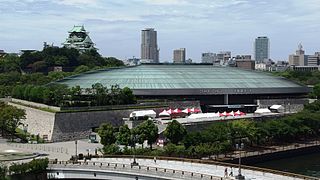Related Research Articles

Michael Lee Alfonso was an American professional wrestler. He was best known for his appearances with the American professional wrestling promotions Extreme Championship Wrestling (ECW), World Championship Wrestling (WCW) and the World Wrestling Federation/Entertainment (WWF/E) under the ring name Mike Awesome and for his appearances in Japan with Frontier Martial-Arts Wrestling and All Japan Pro Wrestling as The Gladiator.

Eiji Ezaki was a Japanese professional wrestler, stage actor, musician and professional wrestling promoter, better known under the ring name Hayabusa. He was best known for his time with Frontier Martial-Arts Wrestling (FMW), where he primarily wrestled throughout his career and was the franchise player of the company between 1995 and 2001.

Atsushi Onita is a Japanese actor, politician, and semi-retired professional wrestler. He is best known for his work in Frontier Martial-Arts Wrestling (FMW) and is credited with introducing the deathmatch style of professional wrestling to Japan. He is a former All Asia Tag Team Champions alongside Yoshitatsu.

Masanori Morimura better known under his ring name Ricky Fuji is a Japanese professional wrestler currently signed to Action Advance Pro Wrestling, where he also runs the day-to-day operations. He is perhaps best known for his time with Frontier Martial-Arts Wrestling (FMW), where he wrestled between the promotion's early days in 1990 until the promotion's closure in 2002, making him the longest-tenured wrestler in the company's history.
The FMW Women's Championship consisted of two Japanese women's professional wrestling championships, the FMW Independent Women's Championship and the WWA World Women's Championship. The championships were contested in the promotion Frontier Martial-Arts Wrestling (FMW). During the heyday of FMW, the female wrestlers wrestled in the same types of bloody death matches as the FMW men, and were feared by other Japanese female wrestlers for their toughness and intensity.

Yukihiro Kanemura, better known by his ring name Kintaro Kanemura, is a Zainichi Korean retired professional wrestler. He also wrestled under the ring name Wing Kanemura. He is best known for his death matches in Apache Army, Big Japan Pro Wrestling (BJW), Extreme Championship Wrestling (ECW), Frontier Martial-Arts Wrestling (FMW), International Wrestling Association (IWA) and Wrestling International New Generations (W*ING).
Koji Nakagawa is a Japanese semi-retired professional wrestler best known for his work in Frontier Martial-Arts Wrestling (FMW) between 1992 and 2002. He is perhaps best known for his “Hitman” character, heavily inspired by Canadian professional wrestler Bret Hart. Nakagawa also wrestled as Goemon between 2000 and 2002, a dark thief character that was eventually killed and turned into a ghost in storyline.
The FMW Anniversary Show was the biggest annual professional wrestling supercard promoted by the Japanese hardcore wrestling promotion Frontier Martial-Arts Wrestling (FMW) between 1990 and 2001 to celebrate the anniversary of the company. The ninth edition of the event was the first to be broadcast on pay-per-view.

FMW 2nd Anniversary Show: Fall Spectacular (1991) was a professional wrestling event produced by Frontier Martial-Arts Wrestling (FMW). The event took place on September 23, 1991 at the Kawasaki Stadium in Kawasaki, Kanagawa, Japan. This was FMW's first show at the venue and it would become a venue for FMW's future major events. This was the second edition of the company's flagship event Anniversary Show, commemorating the second anniversary of the company.

FMW 3rd Anniversary Show: Fall Spectacular (1992) was a professional wrestling event produced by Frontier Martial-Arts Wrestling (FMW). The event took place on September 19, 1992 at the Yokohama Arena in Yokohama, Japan. This was the third edition of the company's flagship event Anniversary Show, commemorating the third anniversary of the company.

FMW 4th Anniversary Show: Origin was a professional wrestling event produced by Frontier Martial-Arts Wrestling (FMW). The event took place on May 5, 1993 at the Kawasaki Stadium in Kawasaki, Kanagawa, Japan. This was the fourth edition of the company's flagship event Anniversary Show, commemorating the fourth anniversary of the company.
Year End Sensation was a series of touring events produced by Frontier Martial-Arts Wrestling (FMW) taking place annually in the month of December. The intent of the series was to conclude the storylines by the end of the year and head into the new year. The event started in 1993 as a supercard titled Year End Spectacular and then the event was incorporated into a tour after FMW began producing wrestling series in 1995. The event was renamed Year End Sensation and continued as a tour until 2000. The last event promoted as Year End Spectacular took place in 1996. It was considered one of the FMW's four big supercards of the year, along with FMW Anniversary Show, Summer Spectacular and Fall Spectacular before FMW began producing pay-per-view events in 1998.

Hideo Takayama was a Japanese professional wrestler, better known under the ring name BADBOY Hido or simply Hido. He is best known for his time with hardcore wrestling federations Big Japan Pro Wrestling (BJW), Independent Wrestling Association Mid-South (IWA-MS), Frontier Martial-Arts Wrestling (FMW) and Wrestling International New Generations (W*ING).
Year End Spectacular (1993) was a major professional wrestling event produced by Frontier Martial-Arts Wrestling (FMW). The event took place on December 8, 1993 at the Tokyo International Trade Harumi Dome in Tokyo, Japan. This was the first Year End Spectacular event and would set the stage for future major events in FMW to close the month of December.

Year End Spectacular (1996) was the third and final Year End Spectacular professional wrestling event produced by Frontier Martial-Arts Wrestling on December 11, 1996. The event was a part of the 1996 Year End Sensation tour, which concluded with the Year End Spectacular event.
Summer Spectacular was a major annual professional wrestling event produced by Frontier Martial-Arts Wrestling during the month of August. The supercard was first held in 1990 in response to World Wrestling Federation's August event SummerSlam. The event would return and be held for two consecutive years in 1993 and 1994. The 1996 edition was subtitled "Shiodome Legend", which would become the event's name for the 1997 edition. This would be the last edition as FMW began producing pay-per-view events in 1998. The event was considered one of the FMW's four big supercards of the year, along with FMW Anniversary Show, Fall Spectacular and Year End Spectacular.

Summer Spectacular (1994) was the third Summer Spectacular professional wrestling event produced by Frontier Martial-Arts Wrestling (FMW). The event took place on August 28, 1994 at the Osaka-jō Hall in Osaka, Japan.
Summer Spectacular (1996) was the fourth Summer Spectacular professional wrestling event produced by Frontier Martial-Arts Wrestling (FMW). The event took place on August 1, 1996 at the Shiodome in Tokyo, Japan.
Katsuji Ueda was a Japanese kickboxer, martial artist and professional wrestler, best known for his time with Frontier Martial-Arts Wrestling (FMW) between 1990 and 1995. He was usually utilized in martial arts fights during his FMW career and won the promotion's World Light Heavyweight Championship three times. He was also a bodyguard for Atsushi Onita.
Mitsuhiro Matsunaga is a Japanese retired professional wrestler best known for his deathmatch wrestling style, having competed in memorable deathmatches in Big Japan Pro Wrestling (BJW), Frontier Martial-Arts Wrestling (FMW) and Wrestling International New Generations (W*ING). He is renowned for participating in the first-ever deathmatch in Japanese wrestling history on December 10, 1989 and is also credited for participating in a Piranha Deathmatch against Kendo Nagasaki on August 19, 1996, which has been considered to be the most popular and greatest deathmatch in Japanese wrestling history by wrestling journalists and many sports websites and Matsunaga has received critical acclaim for his performance.
References
- ↑ "FMW Fall Spectacular 1991". Pro Wrestling History. Retrieved 2017-12-09.
- ↑ "FMW Fall Spectacular 1992". Pro Wrestling History. Retrieved 2017-12-09.
- ↑ "FMW Fall Spectacular 1997". Pro Wrestling History. Retrieved 2017-12-09.